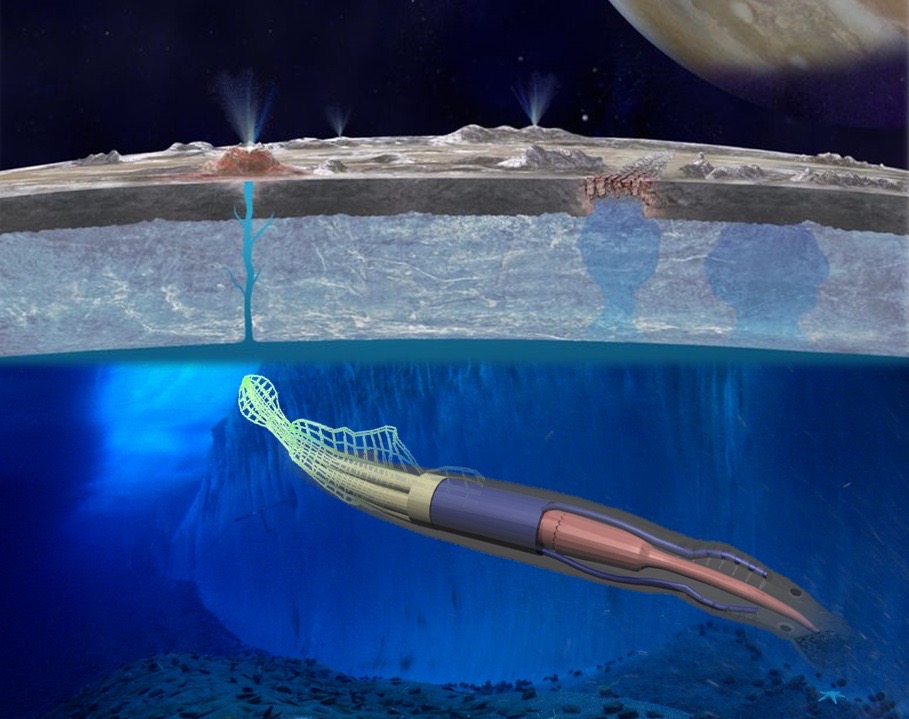NASA Funds 'Squid Rover,' 14 Other Far-Out Space Tech Ideas

NASA has funded 15 ambitious tech concepts in the hopes that one or more of them may have a huge impact on space science or exploration down the road.
The new ideas funded by the NASA Innovative Advanced Concepts (NIAC) program include a squid-like amphibious rover that could explore icy, ocean-harboring moons such as the Jupiter satellite Europa; a proposal to mine water from asteroids using concentrated sunlight; and "WindBots" that would cruise through the skies of Jupiter and Saturn, drawing energy from the gas giants' magnetic fields and powerful winds.
Another concept seeks to develop small, cheap "crawler," "hopper" and ball-like robots that would work together to search for water and other volatile materials in permanently shadowed craters near the poles of the moon. Accessing these volatitles could be key to establishing a human presence on the moon, many researchers say. [How Humans Will Explore the Moon (Infographic)]
The 15 proposals were selected under Phase 1 of the NIAC program. The research teams will each get about $100,000 to perform initial analyses; they can then apply for a Phase 2 award, which is worth an additional $500,000 and funds two more years of development.
"Most of the 2015 NIAC Phase I final candidates were outstanding, and choosing only 15 of them proved to be a challenge," NIAC program executive Jason Derleth said in a statement. "We look forward to seeing how each new study will push boundaries and explore new approaches — that's what makes NIAC unique."
The selected concepts, and their principal investigators, are:
- Virtual Flight Demonstration of Stratospheric Dual-Aircraft Platform (William Engblom, Embry-Riddle Aeronautical University)
- Thirsty Walls: A New Paradigm for Air Revitalization in Life Support (John Graf, NASA's Johnson Space Center)
- A Tall Ship and a Star to Steer Her By (Michael Hecht, Massachusetts Institute of Technology, Haystack Observatory)
- In-Space Manufacture of Storable Propellants (John Lewis, Deep Space Industries)
- DEEP IN Directed Energy Propulsion for Interstellar Exploration (Philip Lubin, University of California, Santa Barbara)
- Triton Hopper: Exploring Neptune's Captured Kuiper Belt Object (Steven Oleson, COMPASS Conceptual Design Team)
- Soft-Robotic Rover with Electrodynamic Power Scavenging (Mason Peck, Cornell University)
- Seismic Exploration of Small Bodies (Jeffrey Plescia, Johns Hopkins University)
- CRICKET: Cryogenic Reservoir Inventory by Cost-Effective Kinetically Enhanced Technology (Jeffrey Plescia, Johns Hopkins University)
- APIS (Asteroid Provided In-Situ Supplies): 100MT Of Water from a Single Falcon 9 (Joel Sercel, ICS Associates Inc.)
- WindBots: Persistent In-Situ Science Explorers for Gas Giants (Adrian Stoica, NASA Jet Propulsion Laboratory)
- Thin-Film Broadband Large Area Imaging System (Nelson Tabirian, BEAM Engineering for Advanced Measurements Co.)
- Aperture: A Precise Extremely large Reflective Telescope Using Re-configurable Elements (Melville Ulmer, Northwestern University)
- CubeSat with Nanostructured Sensing Instrumentation for Planetary Exploration (Joseph Wang, University of Southern California)
- Cryogenic Selective Surfaces (Robert Youngquist, NASA's Kennedy Space Center)
You can learn more about the studies here: http://www.nasa.gov/feature/niac-2015-phase-i-selections
Breaking space news, the latest updates on rocket launches, skywatching events and more!
"The latest NIAC selections include a number of exciting concepts," Steve Jurczyk, associate administrator for the Space Technology Mission Directorate at NASA Headquarters in Washington, said in the same statement. "We are working with American innovators to reimagine the future of aerospace and focus our investments on concepts to address challenges of current interests both in space and here on Earth."
NIAC began in 1998 as the NASA Institute for Advanced Concepts program, and operated in this form through 2007. Congress ordered the U.S. National Research Council to investigate NIAC's effectiveness and importance in 2008; favorable reviews led to the program's resurrection (albeit under a slightly different name) in 2011.
Follow Mike Wall on Twitter @michaeldwall and Google+. Follow us @Spacedotcom, Facebook or Google+. Originally published on Space.com.

Michael Wall is a Senior Space Writer with Space.com and joined the team in 2010. He primarily covers exoplanets, spaceflight and military space, but has been known to dabble in the space art beat. His book about the search for alien life, "Out There," was published on Nov. 13, 2018. Before becoming a science writer, Michael worked as a herpetologist and wildlife biologist. He has a Ph.D. in evolutionary biology from the University of Sydney, Australia, a bachelor's degree from the University of Arizona, and a graduate certificate in science writing from the University of California, Santa Cruz. To find out what his latest project is, you can follow Michael on Twitter.
